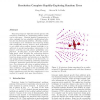Free Online Productivity Tools
i2Speak
i2Symbol
i2OCR
iTex2Img
iWeb2Print
iWeb2Shot
i2Type
iPdf2Split
iPdf2Merge
i2Bopomofo
i2Arabic
i2Style
i2Image
i2PDF
iLatex2Rtf
Sci2ools
ICRA
2002
IEEE
2002
IEEE
Resolution Complete Rapidly-Exploring Random Trees
Trajectory design for high-dimensional systems with nonconvex constraints is a challenging problem considered in this paper. Classical dynamic programming is often employed, but can only find a global optimal solution for low-dimensional problems. Recently, randomized techniques were introduced into trajectory design with considerable success; however, their performance is not reliable when problem domain knowledge is insufficient to provide good guidance information to the planner, and they can only achieve probabilistic completeness. In this paper, we first define the accessibility graph, which describes the connectivity between all of the states accessible from the initial state for a trajectory design problem and provides us an algorithm and analysis framework. Based on the framework, we extend our previous methods by combining randomized techniques, systematic search and state space discretization. One extension will return an optimal solution in
| Added | 15 Jul 2010 |
| Updated | 15 Jul 2010 |
| Type | Conference |
| Year | 2002 |
| Where | ICRA |
| Authors | Peng Cheng, Steven M. LaValle |
Comments (0)

